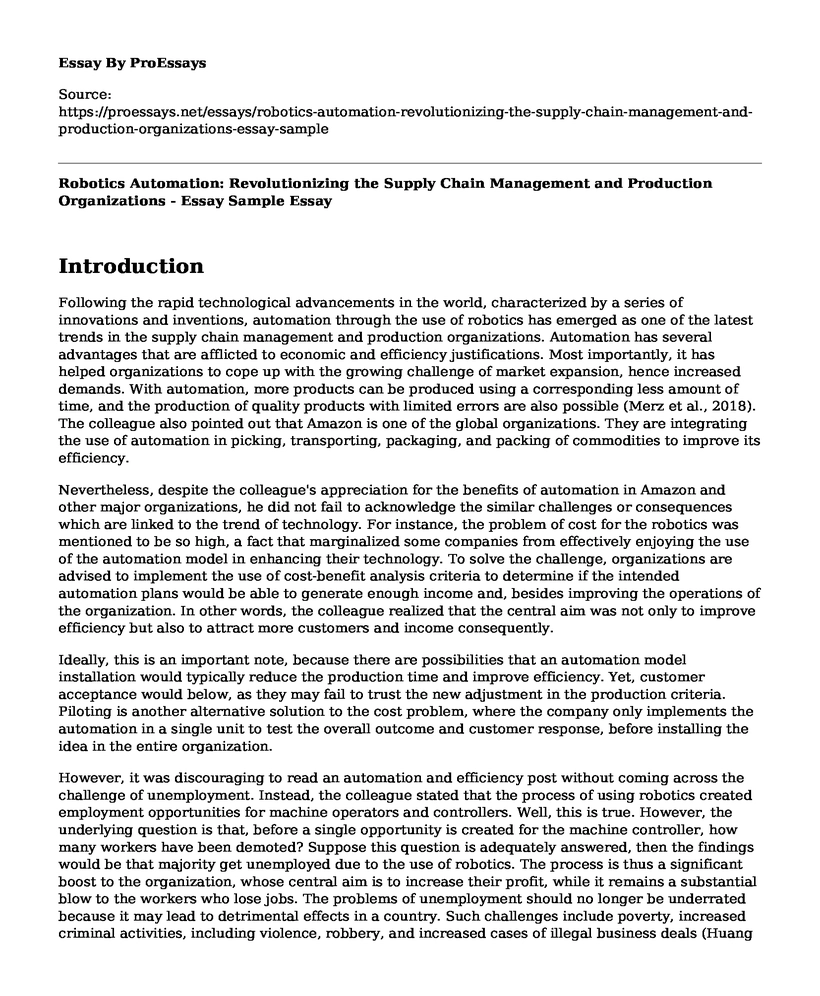Introduction
Following the rapid technological advancements in the world, characterized by a series of innovations and inventions, automation through the use of robotics has emerged as one of the latest trends in the supply chain management and production organizations. Automation has several advantages that are afflicted to economic and efficiency justifications. Most importantly, it has helped organizations to cope up with the growing challenge of market expansion, hence increased demands. With automation, more products can be produced using a corresponding less amount of time, and the production of quality products with limited errors are also possible (Merz et al., 2018). The colleague also pointed out that Amazon is one of the global organizations. They are integrating the use of automation in picking, transporting, packaging, and packing of commodities to improve its efficiency.
Nevertheless, despite the colleague's appreciation for the benefits of automation in Amazon and other major organizations, he did not fail to acknowledge the similar challenges or consequences which are linked to the trend of technology. For instance, the problem of cost for the robotics was mentioned to be so high, a fact that marginalized some companies from effectively enjoying the use of the automation model in enhancing their technology. To solve the challenge, organizations are advised to implement the use of cost-benefit analysis criteria to determine if the intended automation plans would be able to generate enough income and, besides improving the operations of the organization. In other words, the colleague realized that the central aim was not only to improve efficiency but also to attract more customers and income consequently.
Ideally, this is an important note, because there are possibilities that an automation model installation would typically reduce the production time and improve efficiency. Yet, customer acceptance would below, as they may fail to trust the new adjustment in the production criteria. Piloting is another alternative solution to the cost problem, where the company only implements the automation in a single unit to test the overall outcome and customer response, before installing the idea in the entire organization.
However, it was discouraging to read an automation and efficiency post without coming across the challenge of unemployment. Instead, the colleague stated that the process of using robotics created employment opportunities for machine operators and controllers. Well, this is true. However, the underlying question is that, before a single opportunity is created for the machine controller, how many workers have been demoted? Suppose this question is adequately answered, then the findings would be that majority get unemployed due to the use of robotics. The process is thus a significant boost to the organization, whose central aim is to increase their profit, while it remains a substantial blow to the workers who lose jobs. The problems of unemployment should no longer be underrated because it may lead to detrimental effects in a country. Such challenges include poverty, increased criminal activities, including violence, robbery, and increased cases of illegal business deals (Huang et al., 2004). For example, the USA is inarguably the most industrialized nation in the world, but also faces the highest cases of robbery and violence as reports suggest.
Nonetheless, performing cost-benefit analysis is the best solution to the challenge of cost. Meanwhile, to incorporate the problem of unemployment, organizations should consider training their available employees to get the knowledge and skills required for managing the machines instead of recruiting new skillful workers, rendering the old employees unemployed.
References
Huang, C. C., Laing, D., & Wang, P. (2004). Crime and poverty: A searchtheoretic approach. International Economic Review, 45(3), 909-938. https://onlinelibrary.wiley.com/doi/abs/10.1111/j.0020-6598.2004.00291.x
Merz, H., Hansemann, T., & Hubner, C. (2018). Introduction to building automation. In Building Automation (pp. 1-40). Springer, Cham. https://link.springer.com/chapter/10.1007/978-3-319-73223-7_1
Cite this page
Robotics Automation: Revolutionizing the Supply Chain Management and Production Organizations - Essay Sample. (2023, Jun 19). Retrieved from https://proessays.net/essays/robotics-automation-revolutionizing-the-supply-chain-management-and-production-organizations-essay-sample
If you are the original author of this essay and no longer wish to have it published on the ProEssays website, please click below to request its removal:
- Research Paper on Importance of Using Social Media to Drive Sales for a Clothing Brand
- Factors Organization Has to Incur While Recruiting New Employees
- The Principle of Public Relations and Public Affairs Essay
- Competitive Analysis of the Mexican Market in Tire Industry Paper Example
- Hewlett-Packard Company: Network Printer Design for Universality Case Study
- Research Paper on Nanotech in Asia Pacific: Promises and Possibilities
- Why Is Loyalty Important? Marketing Essay Example







